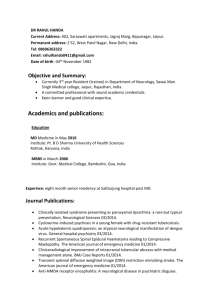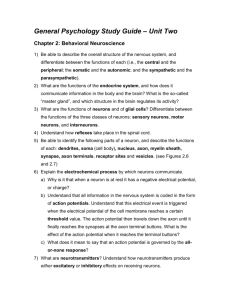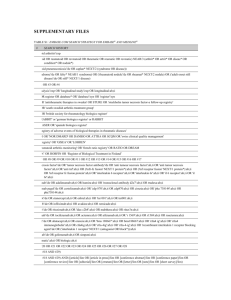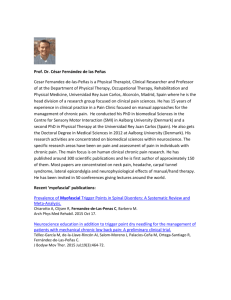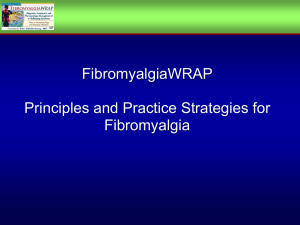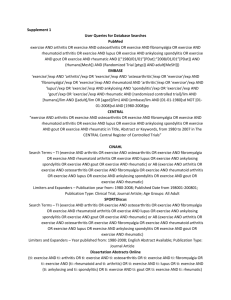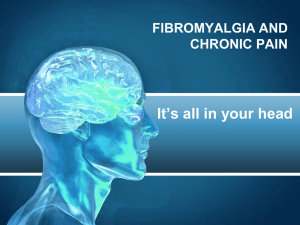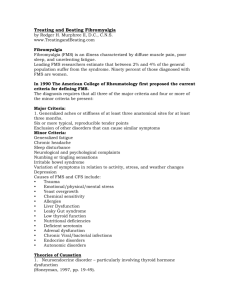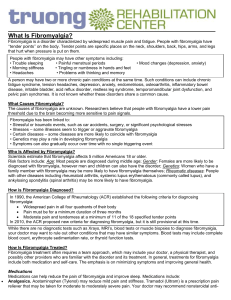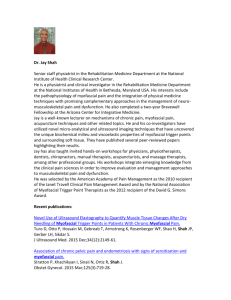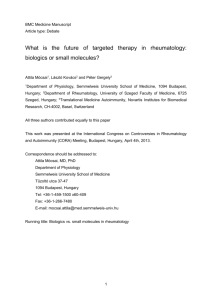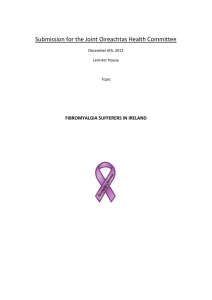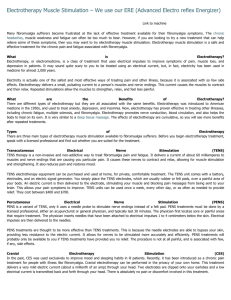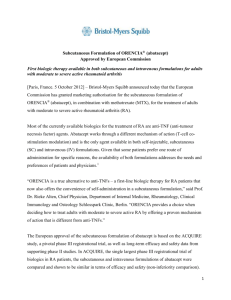Fibromyalgia/Myofascial Pain Syndrome Handout # 3
advertisement
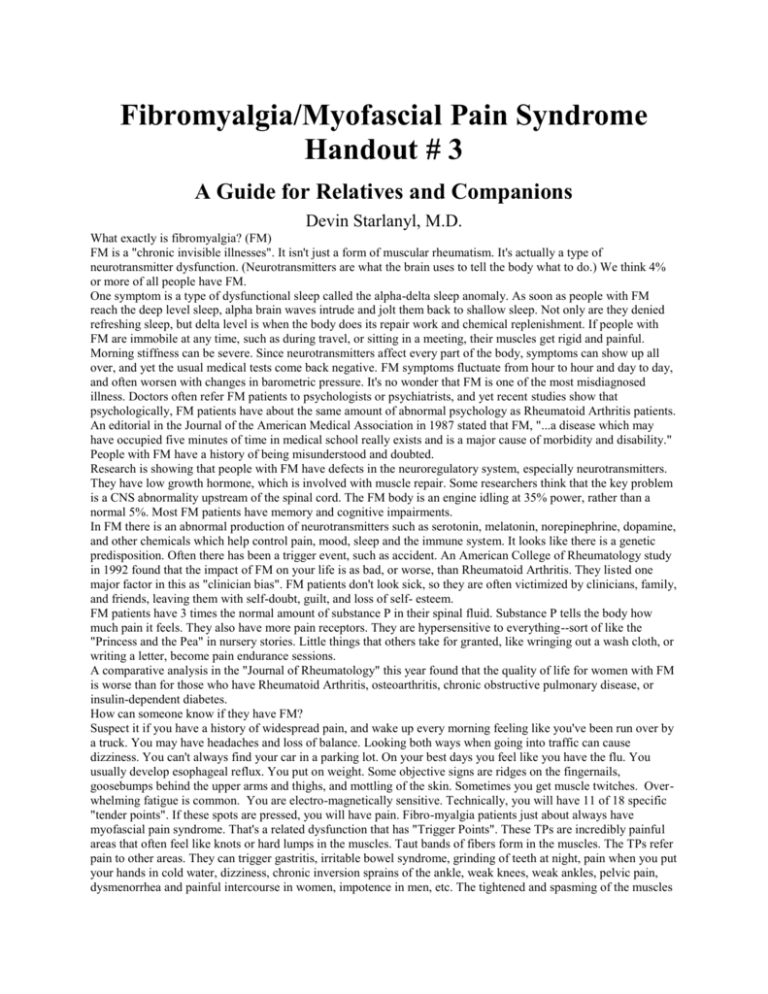
Fibromyalgia/Myofascial Pain Syndrome Handout # 3 A Guide for Relatives and Companions Devin Starlanyl, M.D. What exactly is fibromyalgia? (FM) FM is a "chronic invisible illnesses". It isn't just a form of muscular rheumatism. It's actually a type of neurotransmitter dysfunction. (Neurotransmitters are what the brain uses to tell the body what to do.) We think 4% or more of all people have FM. One symptom is a type of dysfunctional sleep called the alpha-delta sleep anomaly. As soon as people with FM reach the deep level sleep, alpha brain waves intrude and jolt them back to shallow sleep. Not only are they denied refreshing sleep, but delta level is when the body does its repair work and chemical replenishment. If people with FM are immobile at any time, such as during travel, or sitting in a meeting, their muscles get rigid and painful. Morning stiffness can be severe. Since neurotransmitters affect every part of the body, symptoms can show up all over, and yet the usual medical tests come back negative. FM symptoms fluctuate from hour to hour and day to day, and often worsen with changes in barometric pressure. It's no wonder that FM is one of the most misdiagnosed illness. Doctors often refer FM patients to psychologists or psychiatrists, and yet recent studies show that psychologically, FM patients have about the same amount of abnormal psychology as Rheumatoid Arthritis patients. An editorial in the Journal of the American Medical Association in 1987 stated that FM, "...a disease which may have occupied five minutes of time in medical school really exists and is a major cause of morbidity and disability." People with FM have a history of being misunderstood and doubted. Research is showing that people with FM have defects in the neuroregulatory system, especially neurotransmitters. They have low growth hormone, which is involved with muscle repair. Some researchers think that the key problem is a CNS abnormality upstream of the spinal cord. The FM body is an engine idling at 35% power, rather than a normal 5%. Most FM patients have memory and cognitive impairments. In FM there is an abnormal production of neurotransmitters such as serotonin, melatonin, norepinephrine, dopamine, and other chemicals which help control pain, mood, sleep and the immune system. It looks like there is a genetic predisposition. Often there has been a trigger event, such as accident. An American College of Rheumatology study in 1992 found that the impact of FM on your life is as bad, or worse, than Rheumatoid Arthritis. They listed one major factor in this as "clinician bias". FM patients don't look sick, so they are often victimized by clinicians, family, and friends, leaving them with self-doubt, guilt, and loss of self- esteem. FM patients have 3 times the normal amount of substance P in their spinal fluid. Substance P tells the body how much pain it feels. They also have more pain receptors. They are hypersensitive to everything--sort of like the "Princess and the Pea" in nursery stories. Little things that others take for granted, like wringing out a wash cloth, or writing a letter, become pain endurance sessions. A comparative analysis in the "Journal of Rheumatology" this year found that the quality of life for women with FM is worse than for those who have Rheumatoid Arthritis, osteoarthritis, chronic obstructive pulmonary disease, or insulin-dependent diabetes. How can someone know if they have FM? Suspect it if you have a history of widespread pain, and wake up every morning feeling like you've been run over by a truck. You may have headaches and loss of balance. Looking both ways when going into traffic can cause dizziness. You can't always find your car in a parking lot. On your best days you feel like you have the flu. You usually develop esophageal reflux. You put on weight. Some objective signs are ridges on the fingernails, goosebumps behind the upper arms and thighs, and mottling of the skin. Sometimes you get muscle twitches. Overwhelming fatigue is common. You are electro-magnetically sensitive. Technically, you will have 11 of 18 specific "tender points". If these spots are pressed, you will have pain. Fibro-myalgia patients just about always have myofascial pain syndrome. That's a related dysfunction that has "Trigger Points". These TPs are incredibly painful areas that often feel like knots or hard lumps in the muscles. Taut bands of fibers form in the muscles. The TPs refer pain to other areas. They can trigger gastritis, irritable bowel syndrome, grinding of teeth at night, pain when you put your hands in cold water, dizziness, chronic inversion sprains of the ankle, weak knees, weak ankles, pelvic pain, dysmenorrhea and painful intercourse in women, impotence in men, etc. The tightened and spasming of the muscles can entrap nerves, blood vessels, and ducts. You can have blurring of the eyes or double vision. Leg cramps, hypoglycemic-like symptoms, problems swallowing, immune dysfunction, allergies and sensitivities, sciatica, hives and rashes, numbness or tingling, mood swings, confusional states, loss of balance--the list goes on and on. What can we do for someone who has FM? There is no cure for FM/MPS. Many researchers working on it. There are medications that help some of the symptoms. Trigger points can be relieved by some types of physical therapy. It takes a commitment on the part of the patient to practice good nutrition, a program of gentle stretching and moderate exercise, and a recognition of both the patient and her/his companions in life that there are real limitations for people with fibromyalgia. It isn't easy to find the right balance to optimize the quality of life. Be kind. Be patient. Be compassionate. Listen. And ask if there isn't something you can to help.


